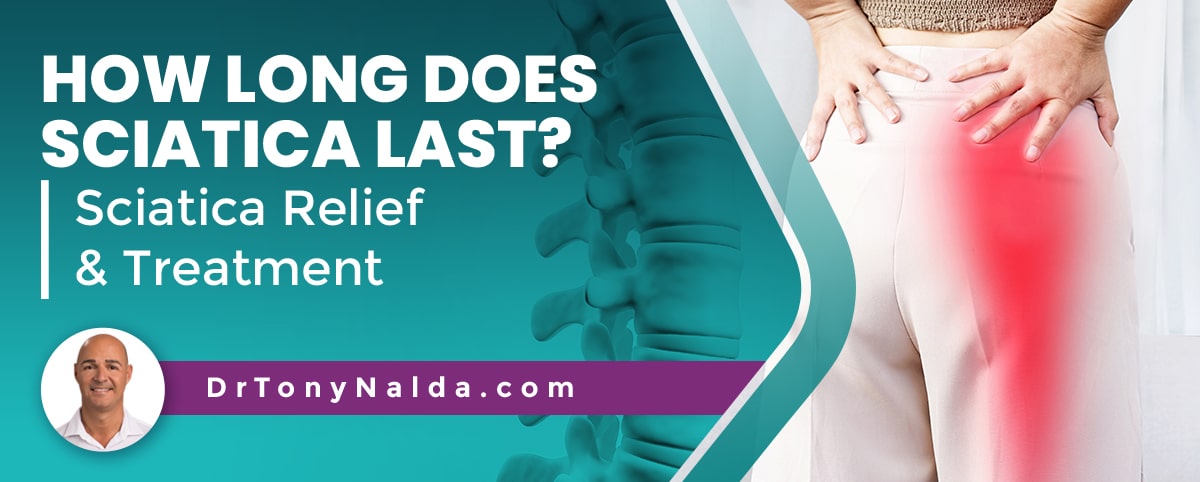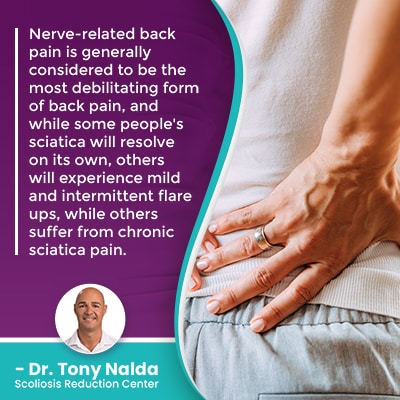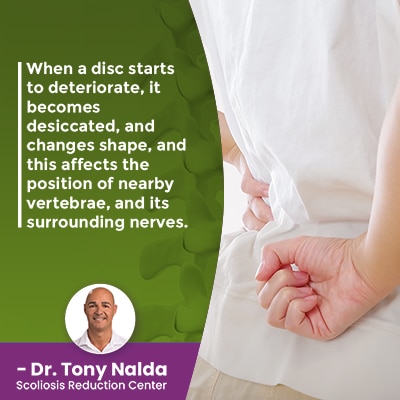How Long Does Sciatica Last? Sciatica Relief & Treatment

There are different causes for sciatica pain, the most common of which is the sciatic nerve being pinched, and when it comes to effective pain relief, we're talking about addressing the cause of the sciatic nerve compression. While some cases of sciatica pain resolve on their own in a few weeks, others experience periods of intense symptoms, known as flare ups, followed by periods with no symptoms or only mild discomfort.
No two cases of sciatic nerve pain are the same. Some people's sciatica will involve mild and intermittent flare ups, while others can involve chronic and debilitating back pain. When it comes to pain relief, proactive treatment that addresses its underlying cause is recommended.
The sciatic nerve runs down the back of the lower body, so symptoms of sciatica most noticeably affect the lower back and body.
Table of Contents
What is Sciatica?
While many people think of sciatica as a condition itself, it more accurately refers to a set of symptoms that include sciatic nerve pain that can be felt at the sciatic nerve's root or anywhere along its extensive pathway.
There are three main spinal sections: the cervical spine (neck), thoracic spine (middle/upper back), and the lumbar spine (lower back).
The sciatic nerve starts in the lumbar spine and runs down the back of the hip, buttock, leg, and into the foot.
The sciatic nerve is the largest in the body and is considered a mixed nerve because it contains both sensory and motor fibers.
In most cases of sciatica, the pain is felt down the left side of the lower body, but it can also be felt down the right side, and affects both rarely.
There are 31 pairs of spinal nerves that exit the spine and branch off in different directions throughout the body, and when a nerve is exposed to uneven pressure at its root, or anywhere along its pathway, it can become irritated, inflamed, pinched, and/or impinged.
When a nerve doesn't have the space it needs to function within, it can cause a number of symptoms and depending on where the pain is felt, it can affect the body in different ways.
So in most cases of sciatica, the sciatic nerve has been pinched, and this can cause a number of symptoms that can vary from patient to patient.
Sciatica Symptoms
 If the sciatic nerve is irritated, it can cause varying levels of localized lower back pain and/or radicular pain felt throughout the lower body: the buttock, back of the thigh, calf, and into the foot.
If the sciatic nerve is irritated, it can cause varying levels of localized lower back pain and/or radicular pain felt throughout the lower body: the buttock, back of the thigh, calf, and into the foot.
Sciatic nerve pain can feel like sharp, hot, stabbing pains, similar to electric shock-like sensations, and/or can also involve sensations of tingling and/or numbness.
Many people experience what are known as flare ups: periods when a condition's symptoms intensify and then abate.
Sitting for long periods of time is known to aggravate sciatica and cause flare ups because the lower back, where the sciatic nerve originates, has to support the weight of the spinal sections above, the trunk, and the vertebrae of the lumbar spine feel the effects of bending, twisting, and lifting heavy objects.
If a person's posture isn't ideal, the sciatic nerve will likely be more irritated and the patient will likely suffer more flare ups because there is an issue with adverse spinal tension and uneven forces that can cause the sciatic nerve to become more pinched, compressed, inflamed, irritated, impinged, and/or damaged.
The added responsibilities of the lower back make it particularly vulnerable to a number of issues/conditions, and sciatic nerve pain is one of them.
Nerve-related back pain is generally considered to be the most debilitating form of back pain, and while some people's sciatica will resolve on its own, others will experience mild and intermittent flare ups, while others suffer from chronic sciatica pain.
For some, sciatic pain increases at night, and can be due to the absence of distractions, difficulty getting comfortable, pressure points, and because the inflammatory process tends to increase at night.
Now that we've addressed the nature of acute sciatica, let's move on to what can be done about acute sciatica pain.
Sciatica Relief and Treatment Options
The cause of a sciatica flare up is the underlying cause of the sciatic nerve pain, which is why it's important that treatment doesn't only address pain; this is the difference between solely addressing pain as a symptom, or addressing its underlying cause for sustainable long term pain relief.
The most common causes of sciatica include spinal degeneration that affects the intervertebral discs, a bulging and/or herniated disc, lumbar spinal stenosis, and spondylolisthesis; however, approximately 90 percent of sciatic nerve pain is caused by disc herniation in the lower back.
The spine consists of vertebrae (bones) that are stacked on top of one another in a straight and neutral alignment, and adjacent vertebral bodies are separated by an intervertebral disc, and those discs are essential to a number of spinal functions.
The discs provide cushioning between adjacent vertebrae to prevent friction during movement, combine forces to facilitate flexibility, act as the spine's shock absorbers, and give the spine structure (adjacent vertebrae attach to the disc in between).
The spine, like the rest of the body, is subject to age-related spinal degeneration, and the spinal discs are generally the first spinal structures to start to deteriorate, and degenerative disc disease is a contributing factor behind the development of a number of spinal issues/conditions.
When a disc starts to deteriorate, it becomes desiccated, and changes shape, and this affects the position of nearby vertebrae, and its surrounding nerves.
The discs have two main structures: an inner gel-like nucleus and a tough and durable outer annulus. When we're born, the discs are made of 80-percent water, but over time, that fluid level decreases, and if a disc experiences excessive fluid loss, it can deteriorate quickly.
 A disc becomes a bulging disc when its inner nucleus starts to push out against its outer annulus, causing it to bulge outwards, and when a disc's inner nucleus pushes through a tear in the outer annulus, this is a herniated disc.
A disc becomes a bulging disc when its inner nucleus starts to push out against its outer annulus, causing it to bulge outwards, and when a disc's inner nucleus pushes through a tear in the outer annulus, this is a herniated disc.
The inner nucleus is then encroaching on space needed by the spine and its surrounding nerves, and if this happens in the lumbar spine, the herniated disc can compress and pinch the sciatic nerve, causing sciatic nerve pain.
Treatment options for sciatica involve first determining its underlying cause, and if disc degeneration is the cause, improving the health, function, and preventing further damage is key, and here at the Scoliosis Reduction Center, I integrate a number of treatment disciplines.
Conclusion
The answer to How long does sciatica last is case-specific. Some people's sciatic pain resolves on its own, others experience flare ups, and some suffer from chronic and debilitating sciatica.
While there are a variety of pain medications (prescription medications, anti inflammatory medications, and steroid injections to reduce inflammation) that can provide temporary relief, to relieve sciatica permanently, its underlying cause has to be addressed.
As the most common cause of sciatic pain is a herniated disc in the lumbar spine, let's focus on treatment for sciatic nerve pain caused by a herniated disc.
When it comes to repairing damage to a degenerating disc, just as the process of disc degeneration takes place slowly over time, so too can the reversal process, and when I say reversing, what I really mean is preserving disc function, preventing more damage and future flare ups, and improving disc health.
Through a combination of condition-specific chiropractic care and physical therapy, I can work towards repositioning vertebrae around an affected disc to take pressure off of it and the sciatic nerve.
I can also use physical therapy to increase blood circulation and blood flow around an affected disc, and this is beneficial because the intervertebral discs don't have their own vascular supply, so increasing circulation means nutrients needed for healing and repair are more accessible.
Also, increasing core strength through physical therapy means the spine is optimally supported by its surrounding muscles, and this means the discs don't have to work as hard and can help prevent future flare ups.
When it comes to proper treatment and effective pain management for sciatica, the first step is determining what's causing the sciatic nerve compression and addressing it proactively.
If a disc issue is the cause, disc health has to be improved/restored, and if the presence of an underlying spinal condition such as lumbar stenosis or spondylolisthesis is the cause, the underlying condition has to be the focus of treatment, and sciatic nerve pain can be improved as its cause is addressed.
Dr. Tony Nalda
DOCTOR OF CHIROPRACTIC
After receiving an undergraduate degree in psychology and his Doctorate of Chiropractic from Life University, Dr. Nalda settled in Celebration, Florida and proceeded to build one of Central Florida’s most successful chiropractic clinics.
His experience with patients suffering from scoliosis, and the confusion and frustration they faced, led him to seek a specialty in scoliosis care. In 2006 he completed his Intensive Care Certification from CLEAR Institute, a leading scoliosis educational and certification center.
About Dr. Tony Nalda
 Ready to explore scoliosis treatment? Contact Us Now
Ready to explore scoliosis treatment? Contact Us Now





